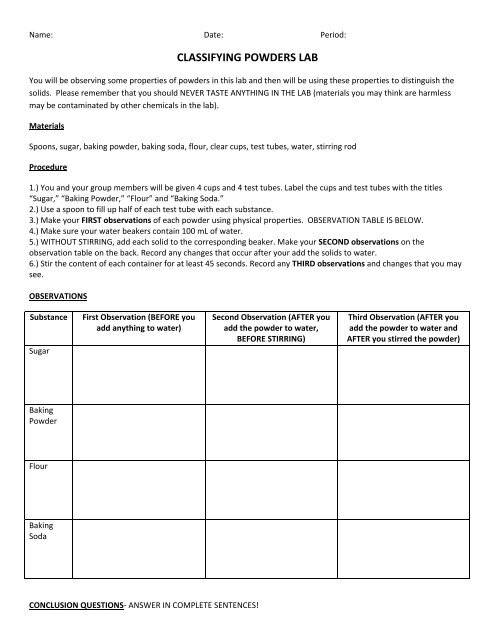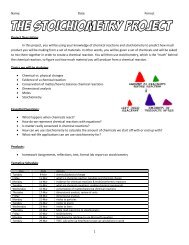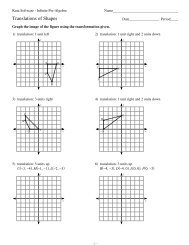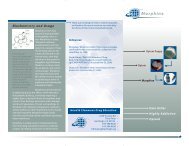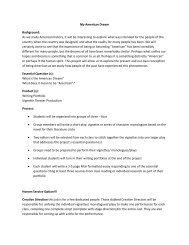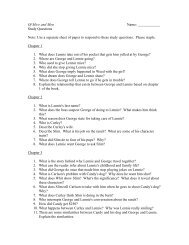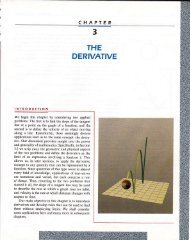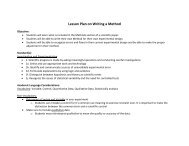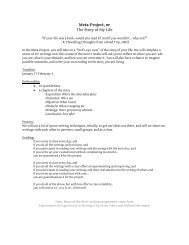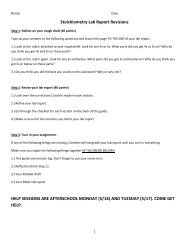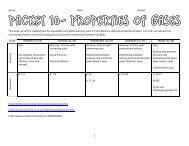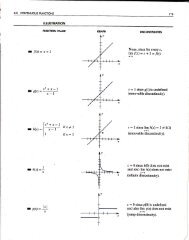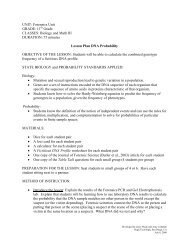Classifying Powders Lab Report Handout
Classifying Powders Lab Report Handout
Classifying Powders Lab Report Handout
- No tags were found...
Create successful ePaper yourself
Turn your PDF publications into a flip-book with our unique Google optimized e-Paper software.
Name: Date: Period:CLASSIFYING POWDERS LABYou will be observing some properties of powders in this lab and then will be using these properties to distinguish thesolids. Please remember that you should NEVER TASTE ANYTHING IN THE LAB (materials you may think are harmlessmay be contaminated by other chemicals in the lab).MaterialsSpoons, sugar, baking powder, baking soda, flour, clear cups, test tubes, water, stirring rodProcedure1.) You and your group members will be given 4 cups and 4 test tubes. <strong>Lab</strong>el the cups and test tubes with the titles“Sugar,” “Baking Powder,” “Flour” and “Baking Soda.”2.) Use a spoon to fill up half of each test tube with each substance.3.) Make your FIRST observations of each powder using physical properties. OBSERVATION TABLE IS BELOW.4.) Make sure your water beakers contain 100 mL of water.5.) WITHOUT STIRRING, add each solid to the corresponding beaker. Make your SECOND observations on theobservation table on the back. Record any changes that occur after your add the solids to water.6.) Stir the content of each container for at least 45 seconds. Record any THIRD observations and changes that you maysee.OBSERVATIONSSubstanceSugarFirst Observation (BEFORE youadd anything to water)Second Observation (AFTER youadd the powder to water,BEFORE STIRRING)Third Observation (AFTER youadd the powder to water andAFTER you stirred the powder)BakingPowderFlourBakingSodaCONCLUSION QUESTIONS- ANSWER IN COMPLETE SENTENCES!
An essential part of conducting experiments in chemistry is reporting your results and findings in a formal labreport. You will be writing a lab report to convey everything you did and learned from the <strong>Classifying</strong> <strong>Powders</strong><strong>Lab</strong>.TITLE PAGEooooThe title of the experiment (Please try to be specific in the title about what we did in the lab). Seenotes at the bottom.Your name and the names of any lab partners.Your instructor's name.The date the report is due.TitleThe title says what you did. It should be brief (aim for ten words or less) and describe the main point of theexperiment or investigation. An example of a title would be: "Effects of Ultraviolet Light on Borax CrystalGrowth Rate". If you can, begin your title using a keyword rather than an article like 'The' or 'A'.What will your TITLE be? _______________________________________________________________IntroductionUsually the Introduction is one paragraph that explains the objectives or purpose of the lab. In onesentence, state the hypothesis. Sometimes an introduction may contain background information, brieflysummarize how the experiment was performed, state the findings of the experiment, and list theconclusions of the investigation. In summary, you need to state the purpose of the experiment, or why youdid it. This would be where you state your hypothesis.Things to include in your introduction: Give a brief summary of what we did in this lab –State what the purpose of doing this lab was – why is it important to be able to describe matter? Whatare some ways in which we describe matter?MaterialsList everything needed to complete your experiment. Be as specific as possible.
Ex: 20 grams of baking soda (not just baking soda)MethodsDescribe the steps you completed during your investigation. This is your procedure. Be sufficiently detailedthat anyone could read this section and duplicate your experiment. Write it as if you were giving direction forsomeone else to do the lab. Write your method in paragraph form. You may use the instructions I gave you,but do NOT copy it word for word. You also need to write your methods section in third person (so do NOTuse words like “I,” “me,” or “you.”DataNumerical data obtained from your procedure usually is presented as a table. Data encompasses what yourecorded when you conducted the experiment. It's just the facts, not any interpretation of what they mean.You also will include any calculations that you may have done.In this lab, your data was simply the observations we made about each powder. All you need to do is type up the table inthe data section and include it in your lab report.Results & DiscussionIn this section, you will further describe in words what the data means.Basically, take the questions from the “Conclusion” section and turn each of them into paragraph form. Pleasemake sure your answers are specific and complete.<strong>Lab</strong> <strong>Report</strong> RubricYou will graded as follows:Categories will be evaluated based on the following scale:
5: Demonstrates mastery, exceeds the average, has a unique and inventive approach4: Demonstrates completion of the requirement, but not mastery3: Demonstrates completion of the requirement, but contains significant distracting errors2: Requirement not fully completed, demonstrates partial understanding1: Incomplete, does not demonstrate understanding of the requirementTitle Page____The title of the experiment (describes the main point of the lab in 10 words or less)____ your name and names of lab partners____ instructor’s name____ date the report is due____ spaced out nicely, is neat, and organized____/5 points = _____ %Introduction____ summary of what we did in this lab____ summary of the purpose of this lab and explains WHY describing matter is necessary____ explains in detail about HOW matter is described____no grammar/spelling mistakes____/20 points = ______%Materials____lists all the materials needed for the experiment____ is specific about the amounts of materials used____/10 points = ______%Methods____lists all the steps of the lab____ is so detailed that anyone could follow the experiment by reading the methods section____ includes specific amounts of materials in the lab____ is written in third person____no grammar or spelling mistakes____/25 points = _______%Data____ includes a table with all the powders and observations on there____table is neat, organized____no spelling or grammar mistakes____/15 points = ________%
Results and Discussion____ includes a thorough, detailed paragraph that answers the question, “What is matter and how do we know that thematerials (sugar, baking powder, flour, and baking soda) we used in this lab were matter?”____ includes a thorough, detailed paragraph that name examples of where you saw solids, liquids and gases in thisexperiment____ includes a thorough, detailed paragraph that discusses what physical properties are, how they were used in this laband how we general use them in science____ includes a thorough, detailed paragraph that discusses the first observation you made (just looking at theappearance of the powders) and explaining if this observation helped you distinguish the powders____ includes a thorough, detailed paragraph that discusses the second observation you made (adding water WITHOUTstirring) and explaining if this observation helped you distinguish the powders____ includes a thorough, detailed paragraph that discusses the third observation you made (stirring the water and thepowder) and explaining if this observation helped you distinguish the powders____ includes a thorough, detailed paragraph that discusses other tests and experiments we can do to help usdistinguish the powders____ includes a thorough, detailed paragraph that explains at least 3 sources of error and how they affect yourexperimental results____ free from grammar and spelling mistakes____/40 points = _______%Other___ put forth sincere effort to refine your lab report_____/5 points = ________%TOTAL SCORE:____________(5%) [TITLE PAGE]____________(15%) [INTRODUCTION]____________(10%) [MATERIALS]____________(15%) [METHODS]____________(20%) [DATA]_ ___________(30%) [RESULTS & DISCUSSION]____________(5%) [CRITIQUES]_____________ TOTAL SCORE


